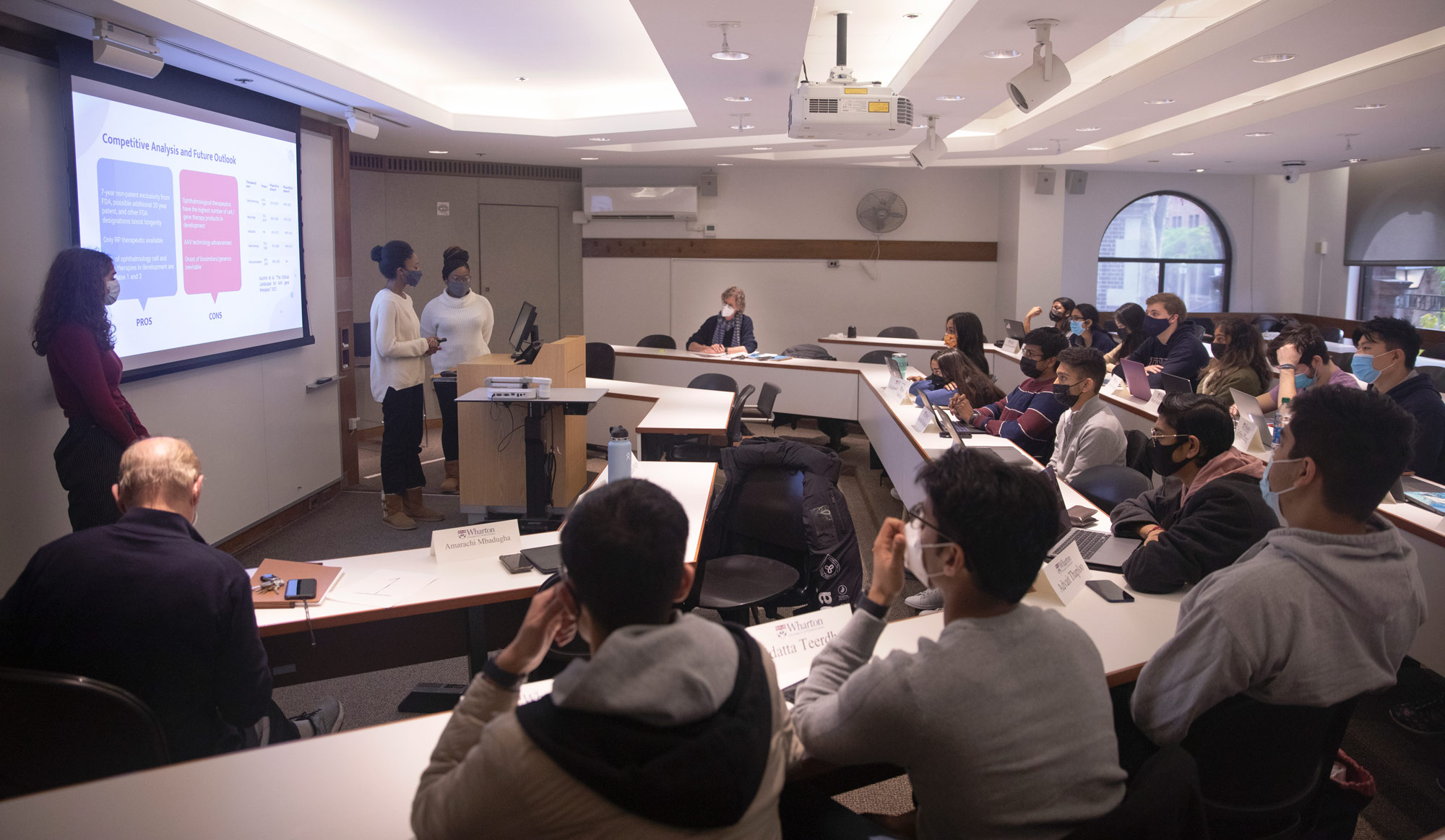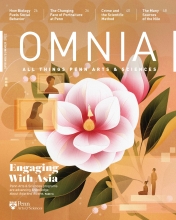Scientific discoveries can’t help patients until those discoveries have made it to the market. To aid that process, the Roy and Diana Vagelos Program in Life Sciences and Management (LSM) was designed to educate students in the life sciences as well as on how to translate lab breakthroughs into medications and other useful products, and how to manage and promote those products. LSM students earn two degrees, one in a life science such as biology or neuroscience from the College of Arts & Sciences and one in economics from Wharton.
LSM accepts just 24 students each year. In the fall of their first year, they’re required to take LSMP 121, the Proseminar in Management and the Life Sciences. Co-taught by program Co-Directors Philip A. Rea, Professor of Biology and Rebecka and Arie Belldegrun Distinguished Director of LSM; and Lawton Robert Burns, James Joo-Jin Kim Professor, Professor of Health Care Management, and Professor of Management in the Wharton School, the course introduces students to the multitude of ways in which the life sciences, society, markets, and firms interact. They examine issues including the creative process and allocation of resources to scientific discovery, the translation of discoveries into products and services, and the marketing of those services, from both an ideal and a real-life perspective.
“What I hope the students get from this gateway course is an appreciation of the sheer breadth of possibilities that this combined education opens up, and eyes for seeing some of the ways in which the material they learn might be deployed and brought to bear on society at large,” says Rea.
“It’s a challenge navigating all the information that’s thrown at you over the semester,” adds Maya Kennedy, C’25, W’25, of Vancouver, British Columbia, who took the course in fall 2021. “But they really make it so there’s support along the way. You’re consistently getting feedback.”
The whole point is to make the students ambidextrous in business and science.
Both Rea and Burns are in every class session. “We have this three-way dialogue going on every single class where they’re getting the biology side from Phil, the business side from me, the interaction of the two, and then speakers coming in who do one or the other,” says Burns. “The whole point is to make the students ambidextrous in business and science and to be able to go back and forth between the two.
“These are first-semester students,” Burns continues. “They’ve never had a course like this before and they manage it really well. I think they’re among the smartest kids at Penn.”
Multiple guest speakers visit during the semester. Rea says they have more than enough volunteers, from leaders in cancer, cardiovascular, vaccine or orphan disease biology, and public health matters to “card-carrying entrepreneurs,” healthcare policy makers, and those concerned with FDA regulatory matters, through to intellectual property attorneys and members of the financial sector.
“We were exposed to cutting-edge research and technology, and the talks are definitely things that I’m going to be thinking about as I’m taking biology classes, business classes, getting involved in clubs, and thinking about my research,” says Adanna Mogbo, C’25, W’25, from Little Rock, Arkansas.
“In most colleges, students learn how to do scientific research or the fundamentals of science, but they don’t really learn how to translate their discoveries to market, which is really the only way it’ll truly bring positive impacts to people,” says Aravind Krishnan, C’25, W’25, from central New Jersey. “Understanding how they were able to translate their innovations from the lab to the market was really impactful.”
One speaker was Sheri Schully, the Deputy Chief Medical and Scientific Officer for the NIH’s All of Us program, which is collecting data from 1 million individuals in the United States, including people who typically haven’t been represented in research. In her talk, she reminded students that to make a broad, long-lasting impact, it has to be population-wide, and that they need to think through the broader implications of any business venture.
“It isn’t only about the scientific validity but also, is it covered by insurance? Do we have the backing of professional organizations? This is how it actually gets into routine clinical care,” says Schully, who is also an LSM program advisor. “We need to be thinking about those things, even when we’re developing our research questions, so that we have that end game in mind of a broader impact and not just one small subset.”
By the end of the fall 2021 semester, the students had written short papers on topics including the creation of the COVID-19 vaccine and how the pandemic exposed inequities in society and healthcare (Rea and Burns update the course every year). Students also composed a final paper on how to repurpose a current product and worked in small groups on a market scan that outlined a translational strategy for a scientific discovery.
Krishnan’s final paper proposed using a current medication for alcohol abuse to treat pediatric neuroblastoma. He addressed promising results from clinical trials but also regulatory issues like FDA approval, patent protection, and the market landscape, and says the work was “really eye-opening.”
About the market scan, Mogbo says, “Whenever I buy medication, I don’t think about exactly how everyone is analyzing the information to get that on the shelf, and for me to pick it up. And now I was in the backstage of all of that, trying to figure out what’s the best way to launch this product, while also keeping in mind the patients, and patient population, patient access. It’s almost like a tight rope—you have to balance these two things.”
For such an intense course, students use the word “fun” a lot. The small class size unites the new cohort, and they quickly find themselves part of the larger LSM community. “We had a little retreat early on, and just meeting these upperclassmen and getting advice from them and talking to them about what we needed help with, what we were scared about, and what we were excited about, was really fun,” says Mogbo.
Finishing high school and applying to the LSM program in the midst of a global pandemic has made these students even more determined to make a difference. “If anything, it amplified my interest in the program and the importance of ending healthcare inequities,” says Kennedy. “It underlined the fact that healthcare is so complex.”




